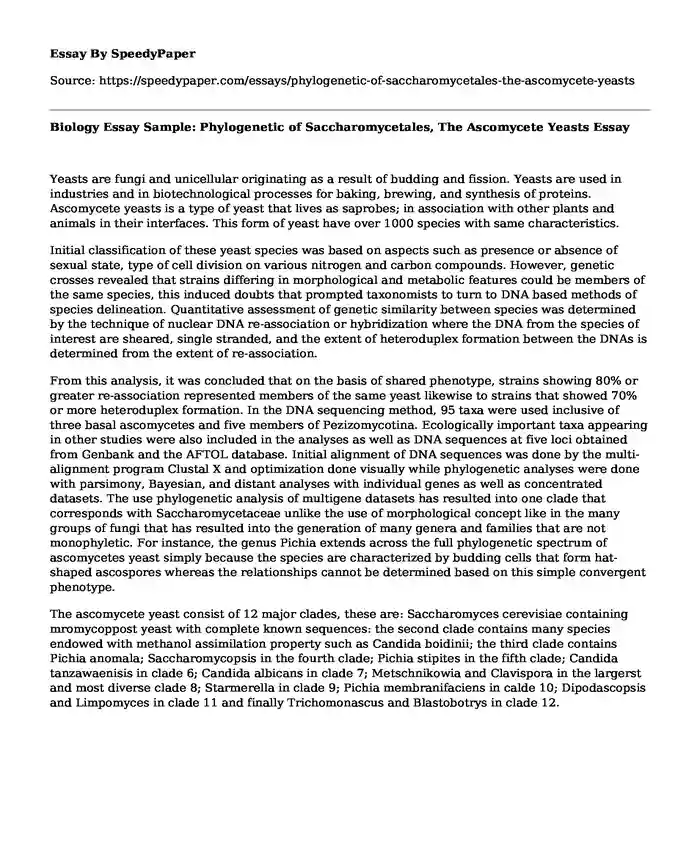Yeasts are fungi and unicellular originating as a result of budding and fission. Yeasts are used in industries and in biotechnological processes for baking, brewing, and synthesis of proteins. Ascomycete yeasts is a type of yeast that lives as saprobes; in association with other plants and animals in their interfaces. This form of yeast have over 1000 species with same characteristics.
Initial classification of these yeast species was based on aspects such as presence or absence of sexual state, type of cell division on various nitrogen and carbon compounds. However, genetic crosses revealed that strains differing in morphological and metabolic features could be members of the same species, this induced doubts that prompted taxonomists to turn to DNA based methods of species delineation. Quantitative assessment of genetic similarity between species was determined by the technique of nuclear DNA re-association or hybridization where the DNA from the species of interest are sheared, single stranded, and the extent of heteroduplex formation between the DNAs is determined from the extent of re-association.
From this analysis, it was concluded that on the basis of shared phenotype, strains showing 80% or greater re-association represented members of the same yeast likewise to strains that showed 70% or more heteroduplex formation. In the DNA sequencing method, 95 taxa were used inclusive of three basal ascomycetes and five members of Pezizomycotina. Ecologically important taxa appearing in other studies were also included in the analyses as well as DNA sequences at five loci obtained from Genbank and the AFTOL database. Initial alignment of DNA sequences was done by the multi-alignment program Clustal X and optimization done visually while phylogenetic analyses were done with parsimony, Bayesian, and distant analyses with individual genes as well as concentrated datasets. The use phylogenetic analysis of multigene datasets has resulted into one clade that corresponds with Saccharomycetaceae unlike the use of morphological concept like in the many groups of fungi that has resulted into the generation of many genera and families that are not monophyletic. For instance, the genus Pichia extends across the full phylogenetic spectrum of ascomycetes yeast simply because the species are characterized by budding cells that form hat-shaped ascospores whereas the relationships cannot be determined based on this simple convergent phenotype.
The ascomycete yeast consist of 12 major clades, these are: Saccharomyces cerevisiae containing mromycoppost yeast with complete known sequences: the second clade contains many species endowed with methanol assimilation property such as Candida boidinii; the third clade contains Pichia anomala; Saccharomycopsis in the fourth clade; Pichia stipites in the fifth clade; Candida tanzawaenisis in clade 6; Candida albicans in clade 7; Metschnikowia and Clavispora in the largerst and most diverse clade 8; Starmerella in clade 9; Pichia membranifaciens in calde 10; Dipodascopsis and Limpomyces in clade 11 and finally Trichomonascus and Blastobotrys in clade 12.
Cite this page
Biology Essay Sample: Phylogenetic of Saccharomycetales, The Ascomycete Yeasts. (2020, Jun 18). Retrieved from https://speedypaper.net/essays/phylogenetic-of-saccharomycetales-the-ascomycete-yeasts
Request Removal
If you are the original author of this essay and no longer wish to have it published on the SpeedyPaper website, please click below to request its removal:
- Psychology Essay Examples
- Women and Gender Studies: Definition Essay Sample
- Free Essay which Compares and Contrasts the Curriculum Approaches: Montessori, High Scope and Reggio Emilio
- Literary Essay Example: Medical Practices in "The Bell Jar"
- Copyright: Ethics Assignment Paper Sample
- Dentistry Essay Sample: Material Method
- Essay Example on Child Therapy Case Consultation
Popular categories





